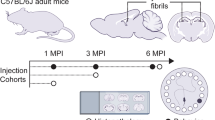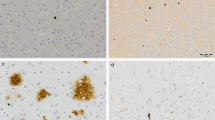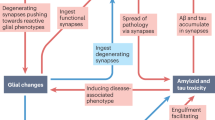Abstract
THERE are many causes of the clinical state dementia. Excluding those patients with tumours, infection or vascular disease, there remains a large group1 whose brains are atrophied and contain an excess of senile morphological change (senile plaques, neurofibrillary degeneration and granulovacuolar change) in the cortex. When this condition occurs before the age of 65 years it is known as presenile dementia or Alzheimer's disease; after this age it has been called senile dementia. Since there is no good reason on pathological grounds2 to maintain this distinction, we use the term Alzheimer's disease irrespective of the patient's age. Together with Parkinson's disease and Huntington's chorea, Alzheimer's disease is one of a group of disorders that Gowers (see ref. 2) called abiotrophies, in which nerve cell loss appears to occur in characteristic patterns (that is, substantia nigra, basal ganglia and cortex, respectively). The cause of this cellular death remains unknown. Morphological assessment of possible nerve cell loss2 or glial cell increase3 has been difficult, particularly in Alzheimer's disease. We have sought therefore to complement histological findings by measuring appropriate biochemical constituents of brain as indices of total neural cell numbers. Whole temporal lobes have been homogenised and analysed and the results expressed per lobe. The results4 suggest that whilst the total number of glial cells is relatively unchanged, there is a loss of approximately half the total nerve cell population. This estimate is based on comparison with age-matched controls, and so the selective neuronal loss is probably a disease-related phenomenon. These findings conform with conclusions drawn from morphological data5.
This is a preview of subscription content, access via your institution
Access options
Subscribe to this journal
Receive 51 print issues and online access
$199.00 per year
only $3.90 per issue
Buy this article
- Purchase on Springer Link
- Instant access to full article PDF
Prices may be subject to local taxes which are calculated during checkout
Similar content being viewed by others
References
Katzman, R., Archs Neurol. 33, 217–218 (1976).
Corsellis, J. A. N. in Greenfield's Neuropathology (eds Blackwood, W. & Corsellis, J. A. N.) 796–848 (Edward Arnold, London, 1976).
Lange, H., Thorner, G., Hopf, A. & Schröder, K. F. J. neurol. Sci. 28, 401–425 (1976).
Bowen, D. M. et al. Brain (in the press).
Colon, E. J. Acta neuropath., Berl. 23, 281–290 (1973).
Bernheimer, H., Birkmayer, W., Hornykiewicz, O., Jellinger, K. & Seitelberger, F. J. neurol. Sci. 20, 415–455 (1973).
Perry, T. L., Hansen, S. & Kloster, M. N. Engl. J. Med. 288, 337–342 (1973).
Bowen, D. M., Smith, C. B., White, P. & Davison, A. N. Brain 99, 459–496 (1976).
Bird, E. D. & Iversen, L. L. Brain 97, 457–472 (1974).
McGeer, P. L. & McGeer, E. G. J. Neurochem. 26, 65–76 (1976).
Blessed, G., Tomlinson, B. E. & Roth, M. Br. J. Psychiat. 114, 797–811 (1968).
Allison, R. S. The Senile Brain (Edward Arnold, London, 1962).
Ingvar, D. H. & Gustafson, L. Acta neurol. scand. Suppl. 43 46, 42–63 (1970).
Bowen, D. M. et al. Brain Res. 117, 503–507 (1976).
Smith, C. B. & Bowen, D. M. J. Neurochem. 27, 1521–1528 (1976).
Bowen, D. M. et al. Brain (in the press).
Enna, S. J. et al. New Engl. J. Med. 294, 1305–1309 (1976).
Abood, L. G. in Drugs Affecting the Central Nervous System (ed. Burger, A.) 127–167 (Edward Arnold, London, 1968).
Karczmar, A. G. in Cholinergic Mechanisms (ed. Waser, P. G.) 506–508 (Raven, New York, 1975).
Drachman, D. A. & Leavitt J. Arch. Neurol. 30, 113–121 (1974).
Pearce, J. & Miller, E. in Clinical Aspects of Dementia (Baillière Tindell, London, 1973).
Bowen, D. M. & Davison, A. N. in Recent Advances in Geriatric Medicine (ed. Issaccs, B.) (Churchill Livingstone, Edinburgh, in the press).
McGeer, E. & McGeer, P. L. in Neurobiology of Aging (ed. Terry, R. D. & Gershon, S.) 389–403 (Raven, New York, 1976).
Davies, P. & Maloney, A. J. F. Lancet ii, 1403 (1976).
Perry, E. K., Perry, R. H., Blessed, G. & Tomlinson, B. E. Lancet i, 187 (1977).
Anon, Lancet i, 408 (1977).
White, P. et al. Lancet i, 668 (1977).
Author information
Authors and Affiliations
Rights and permissions
About this article
Cite this article
SPILLANE, J., WHITE, P., GOODHARDT, M. et al. Selective vulnerability of neurones in organic dementia. Nature 266, 558–559 (1977). https://doi.org/10.1038/266558a0
Received:
Accepted:
Issue Date:
DOI: https://doi.org/10.1038/266558a0
This article is cited by
-
A potential role for apoptosis in neurodegeneration and Alzheimer's disease
Molecular Neurobiology (1995)
-
Monoamine neurotransmitters and their metabolites in brain regions in alzheimer's disease: A postmortem study
Cellular and Molecular Neurobiology (1992)
-
A method for parallel determination of choline acetyltransferase and muscarinic cholinergic receptors: Application in aged-rat brain
Neurochemical Research (1988)
Comments
By submitting a comment you agree to abide by our Terms and Community Guidelines. If you find something abusive or that does not comply with our terms or guidelines please flag it as inappropriate.



